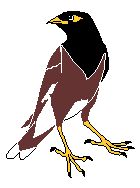Nestbox pests:
Indian myna - the problem
Indian myna - prevention
Indian myna - control
Feral bees - the problem
Feral bees - control
Brushtail possums
Ants
| Indian mynas in nestboxes |
|
|
| Home / Contact us / Product range / Stories / Pest management / Prices |
| Indian mynas
occur naturally from Afghanistan through India to Indochina. They are birds of open
woodland that have adapted easily to open landscapes created by humans. Their
deliberate introductions to Australia started in 1862. Mynas breed in hollows, including nestboxes, and they therefore compete with native cavity-breeders. They are one of the world's most successful birds and a very formidable competitor. Some of their characteristics are: |
|
| * they are very
aggressive; * they are extremely persistent when breeding; * they show no preference for size or shape of hollow or of entrance size; * they build voluminous nests inside hollows which many native birds dislike; * they build dummy nests in adjacent hollows to help protect a breeding territory; * when wet, old nests can "work" like a compost, killing the chicks of those birds which lay on them. |
|
After many years of experimenting with different ways of controlling mynas in nestboxes, we have developed a two part solution to address this problem. The first part is a special nestbox which allows native birds to breed but can also trap feral birds, with all activities being done from the ground. This box also provides for the nest to be easily cleaned from the box. It has been called the MatchBox since its role changes to "match" the circumstances. The second is the trap which allows a feral bird that attempts to breed in the box to be caught. While it can be used with any nestbox, although perhaps with less than perfect success, the MynaVac Trap is best used with the MatchBox because the nest material can then also be dealt with. Additional information on mynas is available at http://www.anu.edu.au/srmes/wildlife/myna.html , which is the source of the above graphic (used with permission). |
|

